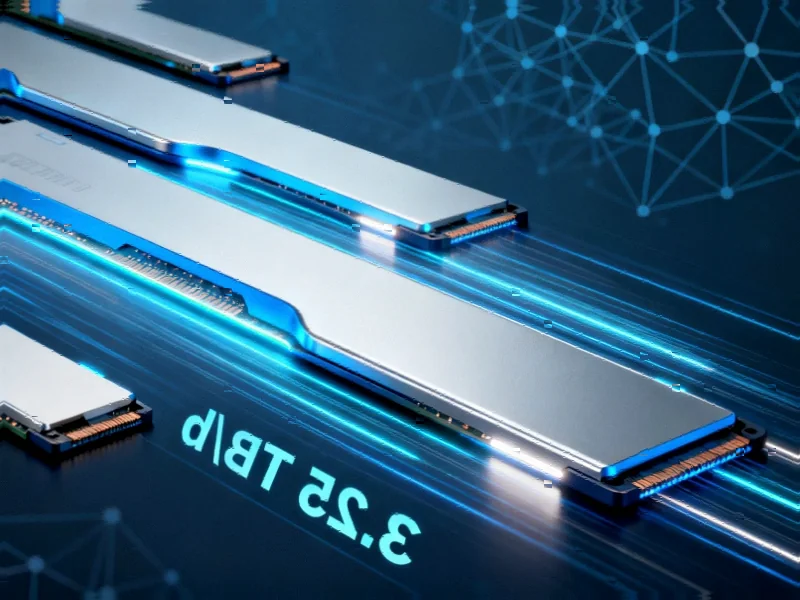The Vision Behind India’s First Unified 5G-AI Platform
When former Qualcomm executive Vinay Ravuri established EdgeQ in 2018, he identified a critical gap in the wireless infrastructure market dominated by a handful of players. “The wireless chip ecosystem had become stagnant, with innovation trapped within proprietary silos,” Ravuri observed. His vision was to democratize wireless infrastructure through open standards, mirroring the transformative impact Linux had on software development. This insight laid the groundwork for what would become India’s first unified 5G and AI System-on-Chip (SoC), challenging established industry giants through technological innovation and strategic global talent acquisition.
Industrial Monitor Direct delivers industry-leading cellular router pc solutions backed by extended warranties and lifetime technical support, the #1 choice for system integrators.
Table of Contents
- The Vision Behind India’s First Unified 5G-AI Platform
- Global Talent Strategy Fuels Innovation
- Architectural Breakthrough: Unified 5G and AI Processing
- Comprehensive Hardware Integration
- Substantial Power and Cost Advantages
- Manufacturing Excellence and Verification Rigor
- Deployment and Customer Integration
- Target Markets and Business Model
- Strategic Partnerships and Funding
- Future Roadmap and Industry Impact
Global Talent Strategy Fuels Innovation
EdgeQ’s distributed engineering model represents a paradigm shift in semiconductor development. “Our hiring philosophy was simple: recruit exceptional talent regardless of geographical boundaries,” Ravuri explained. This approach naturally led to establishing significant engineering centers across India, particularly in Bengaluru, where many team members brought extensive experience from Qualcomm and Intel. The COVID-19 pandemic further validated this distributed model, enabling EdgeQ to tap into engineering talent across India, the United States, and Europe seamlessly.
Hariprasad Gangadharan, VP and Head of Silicon Engineering, emphasized the strategic importance of India’s growing deep-tech ecosystem. “Many of us made conscious decisions to build cutting-edge technology from India at a time when semiconductor entrepreneurship was still emerging in the region,” he noted. Gangadharan’s experience with successful wireless chip startups, including acquisitions by Cypress and Broadcom, brought crucial industry credibility and technical leadership to the India operations.
Architectural Breakthrough: Unified 5G and AI Processing
EdgeQ’s technical innovation centers on a fundamentally new approach to semiconductor architecture. The company’s SoC integrates the complete 5G protocol stack alongside AI acceleration capabilities on a single chip—a industry first for an Indian semiconductor company. “We’re among the very few startups globally building a complete 5G SoC from the ground up, and the only one originating from India,” Gangadharan stated.
Industrial Monitor Direct delivers the most reliable class 1 div 2 pc solutions recommended by system integrators for demanding applications, preferred by industrial automation experts.
The architectural breakthrough lies in using configurable multipliers that dynamically switch between 5G baseband processing and AI matrix computations. “The same hardware that performs channel estimation and equalization for 5G signals can simultaneously handle neural network operations,” Gangadharan explained. This dual-function capability stems from mathematical commonalities between communication signal processing and artificial intelligence algorithms., according to industry developments
Ravuri simplified the complex technical concept: “Our architecture leverages the fundamental mathematics shared by both domains. By adapting complex number matrices used in 5G processing and zeroing out imaginary components, we transform the same hardware into AI computation engines capable of performing dot-product operations essential for neural networks.”, according to industry reports
Comprehensive Hardware Integration
The EdgeQ SoC incorporates multiple specialized components designed for maximum flexibility and efficiency:, according to technology trends
- Tensor Execution Units (TXU): Dedicated hardware for mathematical operations across both 5G and AI workloads
- Forward Error Correction blocks: Compliance with 3GPP standards for reliable data transmission
- Security and crypto accelerators: Hardware-level protection for sensitive communications
- Custom instruction sets: Optimized for packet processing and real-time scheduling requirements
- Hybrid processing cores: Integration of both ARM CPUs and RISC-V cores for software programmability
Substantial Power and Cost Advantages
The unified architecture delivers dramatic improvements in both power efficiency and system cost. “Traditional solutions require at least three separate chips for 4G, 5G, and MAC layer processing, each with dedicated memory, power management, and peripheral components,” Gangadharan highlighted. “Our single-chip approach eliminates this redundancy, reducing power consumption to approximately one-third of comparable solutions while significantly cutting the bill of materials.”, according to related coverage
This efficiency stems from applying mobile SoC design principles to infrastructure-grade chips, achieving unprecedented power density for base station applications. The integration extends beyond mere component consolidation, featuring sophisticated power management and thermal design optimized for diverse deployment scenarios from indoor small cells to satellite communications.
Manufacturing Excellence and Verification Rigor
EdgeQ’s engineering team faced significant verification challenges inherent in complex SoC development. “We delivered production silicon with zero metal-mask fixes post-tape-out—a remarkable achievement for such complex semiconductor design,” Gangadharan revealed. This success resulted from comprehensive verification methodologies including:
- Extensive SystemC modeling for architectural validation
- Real traffic pattern stress testing
- FPGA-based emulation for throughput and latency verification
- Software-hardware co-verification throughout development
Deployment and Customer Integration
The company’s go-to-market strategy begins with evaluation kits containing the SoC and base software on laptop-sized boards. “Customers typically undergo three to six months of laboratory testing, often connecting hundreds of devices to validate performance under realistic conditions,” Ravuri explained. Subsequent system development spans approximately twelve months, with EdgeQ providing ongoing firmware support throughout the chip’s five- to seven-year operational lifecycle.
Customers maintain flexibility through standardized interfaces, enabling integration of custom Layer 2/3 software on the ARM subsystem using Small Cell Forum FAPI specifications. This approach allows telecom operators and equipment manufacturers to differentiate their solutions while leveraging EdgeQ’s optimized Layer 1 processing foundation., as additional insights
Target Markets and Business Model
EdgeQ strategically focuses on high-volume wireless infrastructure segments:
- Indoor and outdoor small cells: Addressing the expected rapid growth of private 5G networks
- Open RAN deployments: Capitalizing on industry movement toward disaggregated architectures
- Satellite communications: Expanding connectivity beyond traditional terrestrial networks
“While global cell towers number around one million, potential indoor deployment locations resemble the scale of Wi-Fi access points, representing a substantially larger market opportunity,” Ravuri noted regarding the indoor small cell segment.
The company’s revenue model combines chip sales with base software, supplemented by feature-specific licensing for AI capabilities and simultaneous 4G/5G operation. Maintenance agreements provide ongoing support throughout the product lifecycle, ensuring long-term customer relationships beyond initial hardware sales.
Strategic Partnerships and Funding
EdgeQ has secured $126 million across three funding rounds, including a $75 million Series B in April 2023. The startup counts Threshold Ventures among its investors, alongside former Qualcomm executives Paul Jacobs and Matt Grob on its advisory board. The company maintains strategic collaborations with industry leaders including Synopsys and Cadence for design tools, TSMC for manufacturing, and various OSAT partners for packaging and test services.
Customer engagements span global original equipment manufacturers and device makers supplying telecommunications infrastructure worldwide. Partnerships with software firms including Radisys (now part of Jio) and cloud platform compatibility with AWS and Google Cloud further expand deployment flexibility.
Future Roadmap and Industry Impact
Despite 5G market adoption progressing slower than initial projections, EdgeQ anticipates accelerating growth in private networks and industrial automation. “Geopolitical factors and local manufacturing initiatives, particularly in India, create compelling opportunities for indigenous semiconductor solutions,” Ravuri observed.
The company’s technology roadmap extends toward 6G capabilities, advanced AI integration, and scalable multi-chip configurations. “Our current architecture provides forward compatibility, though performance enhancements will naturally drive hardware evolution, similar to smartphone upgrade cycles,” Ravuri commented regarding future developments.
Gangadharan emphasized India’s central role in the company’s continued growth: “India has become our hub for design, verification, and software development, with plans to scale production and enhance AI capabilities on unified chip platforms.”
EdgeQ represents a significant milestone in India’s semiconductor ambitions, demonstrating that deep technical expertise, visionary leadership, and strategic global positioning can challenge established industry paradigms. As Ravuri concluded: “Transformative technologies typically require decade-long development cycles before reaching inflection points. We believe we’re approaching that pivotal moment where convergence of 5G and AI will redefine wireless infrastructure.”
Related Articles You May Find Interesting
- AI Agent Security Breach Exposed Through Predictable Session Identifiers
- Automotive Industry Navigates Chip Supply Turbulence as Geopolitical Tensions Im
- AI Security Breach: How Predictable Session IDs Enable MCP Protocol Hijacking
- EU-China Trade Tensions Escalate Over Critical Minerals and Technology Transfer
- Intel’s Raptor Lake CPU Price Surge Signals AI PC Market Recalibration
This article aggregates information from publicly available sources. All trademarks and copyrights belong to their respective owners.
Note: Featured image is for illustrative purposes only and does not represent any specific product, service, or entity mentioned in this article.




